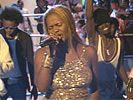Eye For Film >> Movies >> Made In Jamaica (2006) Film Review
This documentary about Jamaican music is as much a snapshot of the state of a nation as it is a primer on the country's pop culture heritage. And given that it opens with news footage documenting the murder of Bogle, a leading light of the dancehall music movement, it's fair to say that the nation is, in some ways, in a bit of a state. He "lived on the edge and died by the gun" says one news report, but it seems for many in the ghetto areas of Kingston and the like "living on the edge" is not so much a life choice as an accident of birth. The resultant picture is one of a fractured society, of absentee fathers and crushing poverty, but where music flows like a life-force.
Thrusting his camera - and us - into the middle of the Wedi Wedi, a weekly (or perhaps more frequent) dance event, director Jérôme Laperrousaz immerses us in the music, an editorial choice that barely lets up throughout the film's runtime. There is no attempt to offer a clear chronology of Jamaican music - a decision that proves somewhat frustrating - rather Laperrousaz shows us the breadth of the country's musical legacy, from reggae to dancehall, intercutting it with interviews in which the various stars talk about their country, their music and their aspirations.

"Reggae is like the blues," says one, "dancehall is like rock n roll." What emerges is a country and music filled with contradiction. On the one hand, there is Rastafarianism - as purveyed by the likes of elder statesman Bunny Wailer - preaching the musical equivalent of 'peace, love and understanding', while on the other is the more visceral and violent in-your-face and in-your-groin rap of Bounty Killer. "We've moulded our chains into guns," says Wailer, when considering the all-too-recent slavery in Jamaica's past.
Also shown in sharp relief is the country's attitude to women. On the one hand many of the male rap stars seem to view them as little more than decorative pieces of skirt to have your way with, while on the other, the likes of female artistes Lady Saw and Tanya Stephens show that sisters can do it for themselves - and frequently with a lot more intelligence than their male counterparts. The biggest flaw here is that, despite its excellent music and infectious energy, Lapperrousaz's documentary feels as though it is constantly skating across the top of much bigger issues that you wish he'd investigate. Scattergun and exasperating in places, this is nevertheless a vibrant and fascinating film, its just a shame Lapperrousaz didn't dig a little deeper.
Reviewed on: 16 Oct 2009



















